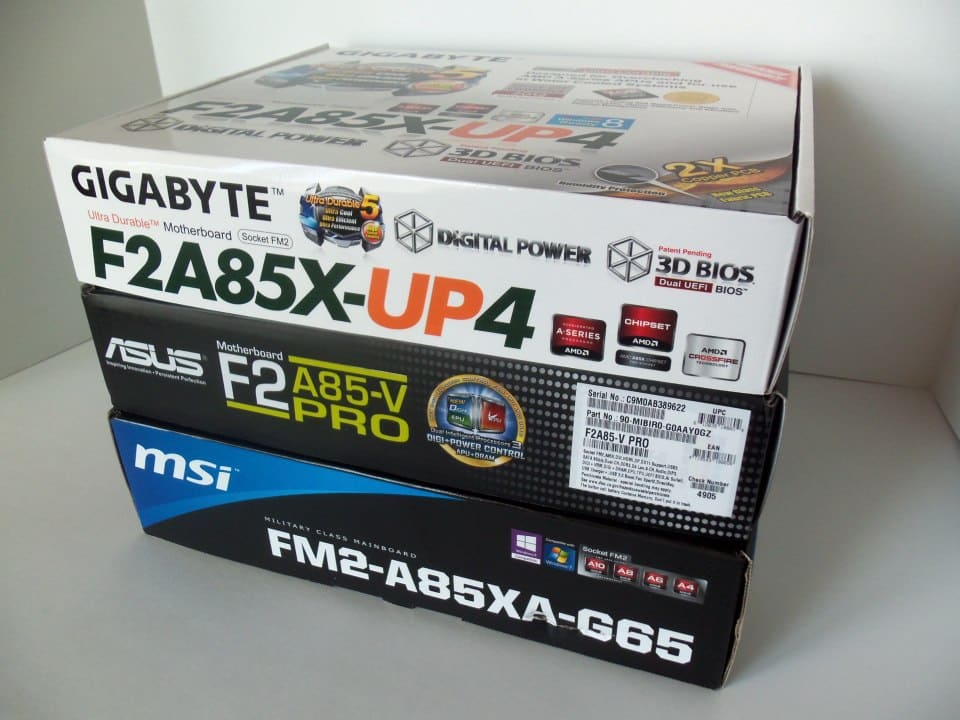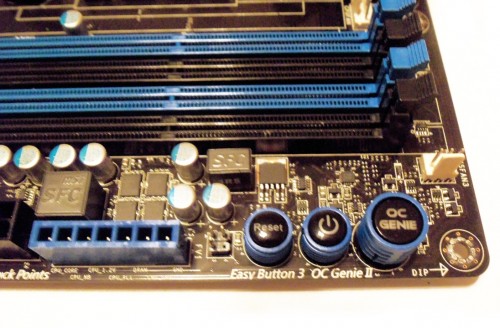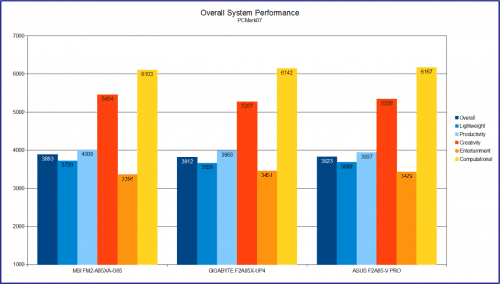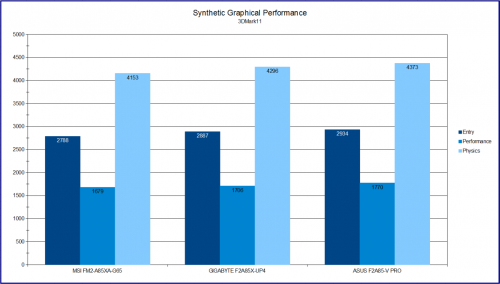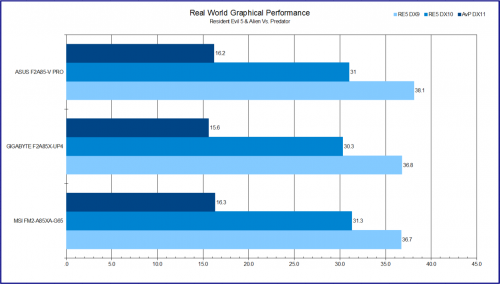Easy Overclocking
Each board is very capable, feature rich, and unrestricted when it comes to overclocking. I easily achieve stable 4.6 GHz with all three boards with ASUS getting a slight advantage thanks to well written help info in the BIOS.
The ASUS F2A85-V PRO and MSI FM2-A85XA-G65 both have mechanical methods of overclocking with the TPU toggle switch and the OC Genie II button respectively. These will switch the board and set all options to tested safe overclocks your APU is known to be stable using. On board boards this resulted in a 4.3 GHz overclock with voltage settings around 1.4 V which is a little high for only 100 MHz over the AMD Turbo Core speed.
The GIGABYTE GA-F2A85X-UP4 does not have a physical overclocking button, but does have a high performance mode. The ASUS F2A85-V PRO also has this same feature and both offer one click access to this via the standard BIOS view. These modes are an interesting hybrid overclock as it keeps most of the power management options enabled, allowing you to have the best of both worlds.
The High Performance Mode increases the AMD Turbo Core speed up to 4.3 GHz and increases the voltage by 0.5 to ensure stability. The increased speed doesn’t seem to be the reason for the minimum performance improvement. It seems to steam from how the power management features are set as AMD Turbo Core is used more often and longer since the system is no longer attempting to save energy first.
The manual option is always the one you go with when you want the maximum yields. Once I disabled the low power states, AMD Cool & Quiet, and AMD Turbo Core I moved on to each boards respective overclocking sections. While all offer a number of power options, I found it best to leave most of them alone and only use the CPU voltage and loadline calibration. I was able to get my AMD A10-5800K up to 4.6 GHz stable with minimal effort. Going beyond this speed always resulted in stability issues.
Test System Setup
The test system is pretty much the same configuration from previous AMD APU testing. The system reflects what I consider a common build around the Trinity and Virgo platform with the bonus of an SSD. The SSD ensures data access speed is not limiting performance results in any way. I decided to leave out a dedicated graphics card as I believe most people who use this platform will either never have one or will add one later on as an upgrade. Plus, we’ll want to see how each board affects the performance of the APU specifically.
Hardware
- Motherboards:
- GIGABYTE GA-F2A85X-UP4GA (BIOS version F3k)
- ASUS F2A85-V PRO (BIOS version 5109)
- MSI FM2-A85XA-G65 (BIOS version 1.5)
- CPU: AMD A10-5800K 3.8 GHz (4.2 GHz Max Turbo) Socket FM2
- GPU: AMD on-die Radeon HD 7660D
- Memory: G.Skill Ripjaws X 2133 MHz (9-11-10-27) @ 1866 MHz (9-10-9-27)
- Power Supply: Antec 850W HCP 80+ Gold
- Case: SilverStone TJ04-EW
- SSD: Patriot Pyro SATA III MLC 60 GB (Sandforce 2281 controller)
- HDD: Western Digital WD1000DHTZ 1 TB VelociRaptor 10k RPM
- USB 2.0: Corsair Flash Voyager 16 GB
- USB 3.0: Rosewill External Enclosure + Western Digital WD1000DHTZ 1 TB VelociRaptor 10k RPM
Software
- PCMark07
- 3DMark11
- Alien Vs. Predator DX11 benchmark
- Resident Evil 5 DX10/DX9 benchmark
- FRAPS
- Metro 2033
- Battlefield 3
- CrystalDiskMark 3.0.1
- OCCT’
- ATTO Disk Benchmark
- FurMark Burn-in
- RightMark Audio Analyzer 6.2.3
- AMD Catalyst 12.11 Drivers
Although Windows 8 is the latest OS on the block, Windows 7 will remain our desktop OS of choice for now. Let’s get testing!
Overall System Performance (PCMark07)
PCMark07 provides a very comprehensive set of real world simulations to gauge performance. Results show a variety of categories and can often comparatively show weaknesses in a system.
I did get very erratic performance from the GIGABYTE GA-F2A85X-UP4 and ASUS F2A85-V PRO due to the aggressive power management systems. Tests were done with these two in High Performance modes enabled instead of normal, but with auto overclocking features all disabled. MSI does not have this issue as it only has two power modes, Power Saving and Normal. Its third mode is OC Genie II which is manual overclocking control, and is not the same as what is offered with the two other boards.
MSI comes out ahead here as it seems to have no restrictions on performance when in normal mode. GIGABYTE and ASUS both come in behind in most tests, but not by enough to matter and both of them pull ahead in the Entertainment and Computational tests, despite the aforementioned erratic behaviour.
Synthetic Graphical Performance (3DMark11)
This is very straight forward test of the theoretical gaming performance. All three boards having the same 6+2 power phase design, but three different engineering designs. While the overall performance was similar there is some deviation. We will see if that difference continues into graphical performance.
In this test it would seem GIGABYTE and ASUS have taken off the kid gloves. The power management system seems to have taken a back seat here as both move ahead of MSI by a small margin with ASUS taking the lead. Even with the auto OC features disabled on all boards, I am not sure if these results are a fluke or not.
Real World Graphical Performance (Alien Vs. Predator, Resident Evil 5)
The best way to determine if a test result is believable is to test again from a different perspective. As always, the AvP benchmark is done with the default settings with DX11 mode enabled, tessellation on, with high detail at 1920 x 1080. Resident Evil 5 is tested at max settings with frame rate unlocked and Vsync disabled with the same screen resolution.
These results are a lot more ambiguous as each motherboard falls very close to each other in performance. ASUS takes the lead in DX9 and MSI takies the other two. With all three boards coming between 0.7 to 1.1 FPS of each other in these tests, I can’t say there is a clear victory to be had.
Now lets push the boundaries to the absolute edge by finishing off with Battlefield 3 peformance!

